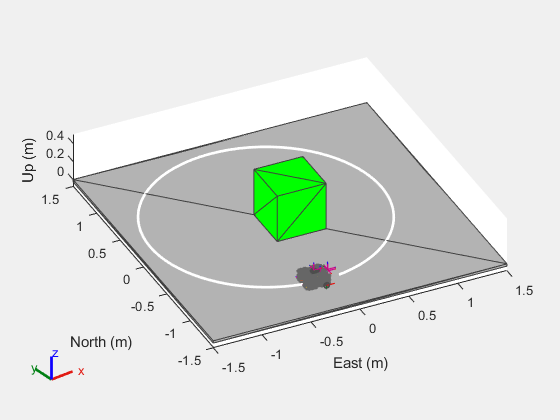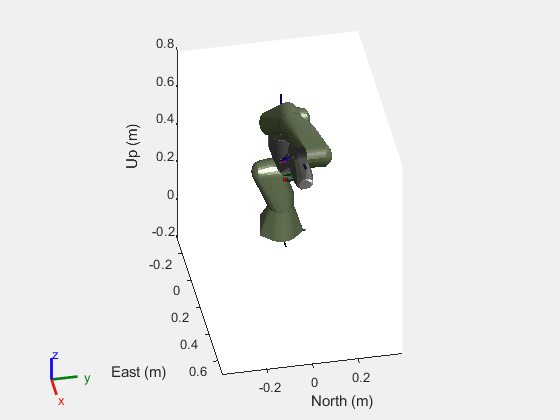updateMesh
Description
updateMesh(
updates the body mesh of the robot platform with the specified mesh type and specifies
additional options using one or more name-value arguments.platform,type,Name=Value)
Examples
Create a robot scenario.
scenario = robotScenario(UpdateRate=100,StopTime=1);
Add the ground plane and a box as meshes.
addMesh(scenario,"Plane",Size=[3 3],Color=[0.7 0.7 0.7]); addMesh(scenario,"Box",Size=[0.5 0.5 0.5],Position=[0 0 0.25], ... Color=[0 1 0])
Create a waypoint trajectory for the robot platform using an ENU reference frame.
waypoint = [0 -1 0; 1 0 0; -1 1 0; 0 -1 0]; toa = linspace(0,1,length(waypoint)); traj = waypointTrajectory("Waypoints",waypoint, ... "TimeOfArrival",toa, ... "ReferenceFrame","ENU");
Create a rigidBodyTree object of the TurtleBot 3 Waffle Pi robot with loadrobot.
robotRBT = loadrobot("robotisTurtleBot3WafflePi");Create a robot platform with trajectory.
platform = robotPlatform("TurtleBot",scenario, ... BaseTrajectory=traj);
Set up platform mesh with the rigidBodyTree object.
updateMesh(platform,"RigidBodyTree",Object=robotRBT)Create an INS sensor object and attach the sensor to the platform.
ins = robotSensor("INS",platform,insSensor("RollAccuracy",0), ... UpdateRate=scenario.UpdateRate);
Visualize the scenario.
[ax,plotFrames] = show3D(scenario); axis equal hold on
In a loop, step through the trajectory to output the position, orientation, velocity, acceleration, and angular velocity.
count = 1; while ~isDone(traj) [Position(count,:),Orientation(count,:),Velocity(count,:), ... Acceleration(count,:),AngularVelocity(count,:)] = traj(); count = count+1; end
Create a line plot for the trajectory. First create the plot with plot3, then manually modify the data source properties of the plot. This improves the performance of the plotting.
trajPlot = plot3(nan,nan,nan,"Color",[1 1 1],"LineWidth",2); trajPlot.XDataSource = "Position(:,1)"; trajPlot.YDataSource = "Position(:,2)"; trajPlot.ZDataSource = "Position(:,3)";
Set up the simulation. Then, iterate through the positions and show the scene each time the INS sensor updates. Advance the scene, move the robot platform, and update the sensors.
setup(scenario) for idx = 1:count-1 % Read sensor readings. [isUpdated,insTimestamp(idx,1),sensorReadings(idx)] = read(ins); if isUpdated % Use fast update to move platform visualization frames. show3D(scenario,FastUpdate=true,Parent=ax); % Refresh all plot data and visualize. refreshdata drawnow limitrate end % Advance scenario simulation time. advance(scenario); % Update all sensors in the scene. updateSensors(scenario) end hold off

Create a robotScenario object.
scenario = robotScenario(UpdateRate=1,StopTime=10);
Create a rigidBodyTree object of the Franka Emika Panda manipulator using loadrobot.
robotRBT = loadrobot("frankaEmikaPanda");Create a rigidBodyTree-based robotPlatform object using the manipulator model.
robot = robotPlatform("Manipulator",scenario, ... RigidBodyTree=robotRBT);
Create a non-rigidBodyTree-based robotPlatform object of a box to manipulate. Specify the mesh type and size.
box = robotPlatform("Box",scenario,Collision="mesh", ... InitialBasePosition=[0.5 0.15 0.278]); updateMesh(box,"Cuboid",Collision="mesh",Size=[0.06 0.06 0.1])
Visualize the scenario.
ax = show3D(scenario,Collisions="on");
view(79,36)
lightSpecify the initial and the pick-up joint configuration of the manipulator, to move the manipulator from its initial pose to close to the box.
initialConfig = homeConfiguration(robot.RigidBodyTree);
pickUpConfig = [0.2371 -0.0200 0.0542 -2.2272 0.0013 ...
2.2072 -0.9670 0.0400 0.0400];Create an RRT path planner using the manipulatorRRT object, and specify the manipulator model.
planner = manipulatorRRT(robot.RigidBodyTree,scenario.CollisionMeshes); planner.IgnoreSelfCollision = true;
Plan the path between the initial and the pick-up joint configurations. Then, to visualize the entire path, interpolate the path into small steps.
rng("default")
path = plan(planner,initialConfig,pickUpConfig);
path = interpolate(planner,path,25);Set up the simulation.
setup(scenario)
Check the collision before manipulator picks up the box.
checkCollision(robot,"Box", ... IgnoreSelfCollision="on")
ans = logical
0
Move the joints of the manipulator along the path and visualize the scenario.
helperRobotMove(path,robot,scenario,ax)
Check the collision after manipulator picks up the box.
checkCollision(robot,"Box", ... IgnoreSelfCollision="on")
ans = logical
1
Use the attach function to attach the box to the gripper of the manipulator.
attach(robot,"Box","panda_hand", ... ChildToParentTransform=trvec2tform([0 0 0.1]))
Specify the drop-off joint configuration of the manipulator to move the manipulator from its pick-up pose to the box drop-off pose.
dropOffConfig = [-0.6564 0.2885 -0.3187 -1.5941 0.1103 ...
1.8678 -0.2344 0.04 0.04];Plan the path between the pick-up and drop-off joint configurations.
path = plan(planner,pickUpConfig,dropOffConfig); path = interpolate(planner,path,25);
Move the joints of the manipulator along the path and visualize the scenario.
helperRobotMove(path,robot,scenario,ax)
Use the detach function to detach the box from the manipulator gripper.
detach(robot)
Plan the path between the drop-off and initial joint configurations to move the manipulator from its box drop-off pose to its initial pose.
path = plan(planner,dropOffConfig,initialConfig); path = interpolate(planner,path,25);
Move the joints of the manipulator along the path and visualize the scenario.
helperRobotMove(path,robot,scenario,ax)

Helper function to move the joints of the manipulator.
function helperRobotMove(path,robot,scenario,ax) for idx = 1:size(path,1) jointConfig = path(idx,:); move(robot,"joint",jointConfig) show3D(scenario,fastUpdate=true,Parent=ax,Collisions="on"); drawnow advance(scenario); end end
Input Arguments
Robot platform in the scenario, specified as a robotPlatform object.
Type of mesh, specified as "Cuboid",
"GroundVehicle", "RigidBodyTree", or
"Custom".
Data Types: char | string
Name-Value Arguments
Specify optional pairs of arguments as
Name1=Value1,...,NameN=ValueN, where Name is
the argument name and Value is the corresponding value.
Name-value arguments must appear after other arguments, but the order of the
pairs does not matter.
Example: Scale=2 specifies the scale of the ground vehicle robot
platform mesh as 2.
Relative mesh position in the body frame, specified as a vector of the form
[x
y
z] in meters.
Data Types: single | double
Relative mesh orientation in the body frame, specified as a quaternion vector of
the form [w
x
y
z] or a quaternion object.
Data Types: single | double
Transformation of mesh relative to the body frame, specified as a 4-by-4 homogeneous transformation matrix. The matrix maps points in the platform mesh frame to points in the body frame.
Data Types: single | double
Robot platform body mesh color, specified as a RGB triplet, except for the rigid body mesh.
Data Types: single | double
Faces of the custom robot platform mesh, specified as an N-by-3 matrix of positive integers. The three elements in each row are the indices of the three points in the vertices forming a triangle face. N is the number of faces.
Data Types: single | double
Vertices of the custom robot platform mesh, specified as an N-by-3 matrix of real scalars. The first, second, and third element of each row represents the x-, y-, and z-position of each vertex, respectively. N is the number of vertices.
Data Types: single | double
Size of the cuboid robot platform mesh, specified as a vector of the form
[xlength
ylength
zlength] in meters.
Data Types: single | double
Scale of the ground vehicle robot platform mesh, specified as a scalar. Scale is unitless.
Data Types: single | double
Rigid body tree robot platform, specified as a rigidBodyTree object.
Occupied state of binary occupancy map, specified as true or
false. Set the value as true if robot platform
is incorporated in the binary occupancy map.
Data Types: logical
Collision object to add to the platform mesh, specified as one of these values:
false— Keeps the platform mesh collision-object-free. Clears any existing collision object from therigidBodyTree-based platform mesh."default"— Keeps the existing collision mesh for therigidBodyTree-based platform. For other platforms, keeps the platform mesh collision-object-free."mesh"— Fits a collision object, such ascollisionBox,collisionCylinder,collisionMesh, orcollisionSphere, based on the platform mesh type."capsule"— Fits a collision capsule object to the platform mesh.One of these externally created collision objects:
The rigidBodyTree-based platform accepts an externally created
collision mesh for only the base body.
Data Types: logical | char | string
Transformation of the collision mesh relative to the platform mesh, specified as a
4-by-4 homogeneous transformation matrix. Use the CollisionOffset input for rigidBodyTree-based platforms
only when specifying the Collision input as an externally created collision object.
Data Types: single | double
Version History
Introduced in R2022a
MATLAB Command
You clicked a link that corresponds to this MATLAB command:
Run the command by entering it in the MATLAB Command Window. Web browsers do not support MATLAB commands.
Website auswählen
Wählen Sie eine Website aus, um übersetzte Inhalte (sofern verfügbar) sowie lokale Veranstaltungen und Angebote anzuzeigen. Auf der Grundlage Ihres Standorts empfehlen wir Ihnen die folgende Auswahl: .
Sie können auch eine Website aus der folgenden Liste auswählen:
So erhalten Sie die bestmögliche Leistung auf der Website
Wählen Sie für die bestmögliche Website-Leistung die Website für China (auf Chinesisch oder Englisch). Andere landesspezifische Websites von MathWorks sind für Besuche von Ihrem Standort aus nicht optimiert.
Amerika
- América Latina (Español)
- Canada (English)
- United States (English)
Europa
- Belgium (English)
- Denmark (English)
- Deutschland (Deutsch)
- España (Español)
- Finland (English)
- France (Français)
- Ireland (English)
- Italia (Italiano)
- Luxembourg (English)
- Netherlands (English)
- Norway (English)
- Österreich (Deutsch)
- Portugal (English)
- Sweden (English)
- Switzerland
- United Kingdom (English)